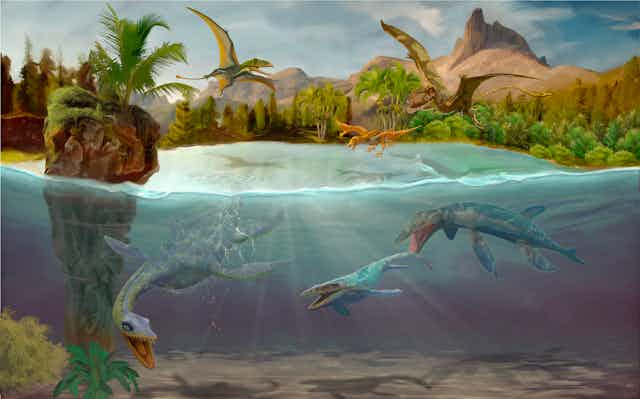If you were asked to think of a mammal, chances are high you would think of a placental mammal – horses, dogs, cats, humans, even bats and rats all fall into that category. It includes some 6,000 species who live in the oceans as well as on land.
Today placentals are by far the most abundant and widespread mammals, although there are two other groups, monotremes (echidnas and platypuses) and marsupials (pouched kangaroos and koalas).
Debate has raged for many years among palaeontologists (who study the earth through fossils) over whether placental mammals, evolved alongside dinosaurs or appeared only after they died out.
My team’s study used a new method to investigate this question and our findings may help settle this debate. We think placental mammals may have evolved roughly 70 million years ago, meaning they would have walked the Earth at the same time as the dinosaurs.
Estimating origins
There are two main methods palaeontologists use to estimate when a group of animals first evolved. The first is reading the fossil record - the oldest fossil in a group determines the date when it first evolved. For placental mammals, there are a couple of fossils from around 65 million years ago, just after the mass extinction of dinosaurs. These include Purgatorius, considered an ancestor of primates (and thus humans).
However, the fossil record is full of gaps. Only a fraction of life has ever been fossilised, and fossil hunters have probably only found a small percentage of the organisms preserved in Earth’s sediments. A species’ chance of featuring in a scientific study as a fossil are similar to winning the lottery.
Another way of estimating when groups first evolved is through molecular clock dating studies. Scientists can compare the DNA of organisms to work out when they emerged as distinct species.
Two species that are similar in their genetic makeup probably have family trees that split from each other fairly recently. Very different species diverge further back in time, allowing for the build-up of more genetic differences.
The genetic difference between two species is roughly proportional to their time of evolutionary divergence, or their origin.
Molecular clock studies of placental mammals suggest the group first evolved in the Cretaceous period, around 80 million years ago and nearly 20 million years before fossils of placental mammals first start to appear. So which is correct?
Rocks or clocks?
In our study, published in Current Biology, my colleagues and I used a new method of interpreting the fossil record to estimate the age of placental mammals: statistical analysis.
First, we gathered records of more than 15,000 fossils of placental mammals, focusing on those that are well-researched enough to place in the placental mammal family tree. The Bayesian Brownian Bridge (BBB) model is a scientific formula that uses the distribution of fossils through time to estimate the age of a group. We used the BBB to estimate the ages of 380 families within placental mammals.
Rather than comparing species directly to each other like in molecular clock studies, the BBB model allowed us to take a wider view and compare families. As well as following the pattern of a family’s diversity through time, the BBB model also estimates a sampling rate, or how frequently fossils appear in the fossil record.
This helped us to fill the gaps in the fossil record.
For young lineages that evolved only a few hundred thousand years ago, this sampling rate may be quite high, because we have more fossils from younger rocks. Younger rocks are more intact, and often closer to the surface. But for older groups, the sampling rate may be quite low because geological processes degrade and destroy rocks and fossils over time.
Additionally, a species needs to be fairly widespread and abundant to be fossilised, otherwise it has very little chance of winning that lottery. Which means the age of a group will always be older than the oldest fossil in that group, but it doesn’t tell us by how much.
The origins of placental mammals
This is what the sampling rate helps with - families with low sampling rates likely had more of a gap between the oldest fossil and the true origin of that family.
The BBB model estimated the age of placental mammals to be within the Cretaceous period, around 70-80 million years ago – possibly up to 20 million years before the asteroid impact.
Our results show that placental mammals co-existed with dinosaurs for several million years. Ancestors to rabbits and hares (Lagomorpha), cats and dogs (Carnivora) and primates probably all evolved in the time of dinosaurs. Early placental mammals were probably small and shrew-like.
From an origin at the feet of dinosaurs, placental mammals have soared to become the most dominant animals on Earth.

